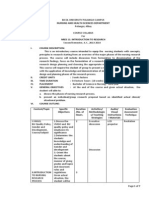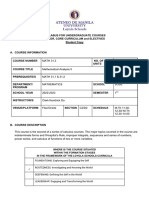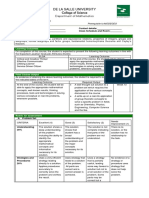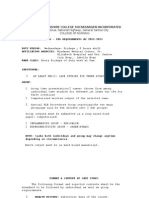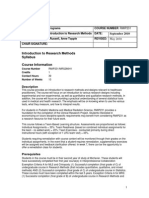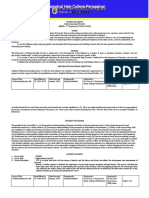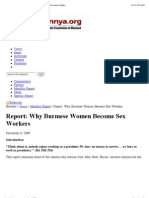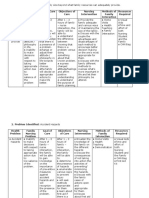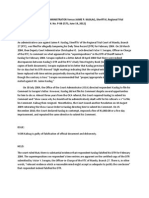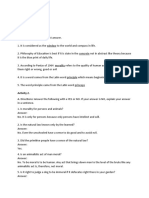Comm I-II Syllabus
Comm I-II Syllabus
Uploaded by
Ria Mikhaella PanisCopyright:
Available Formats
Comm I-II Syllabus
Comm I-II Syllabus
Uploaded by
Ria Mikhaella PanisOriginal Description:
Copyright
Available Formats
Share this document
Did you find this document useful?
Is this content inappropriate?
Copyright:
Available Formats
Comm I-II Syllabus
Comm I-II Syllabus
Uploaded by
Ria Mikhaella PanisCopyright:
Available Formats
COMMUNICATION I-II SYLLABUS
First semester, SY 2012-2013 Department of Arts and Communication College of Arts and Sciences University of the Philippines Manila
Instructor:
Mishima Z. Miciano Department of Arts and Communication, Rm 703, Rizal Hall Tel: 523-1628 Communication Skills Communication I: The development of advanced communicative competence in English, with emphasis on effective reading, writing, and listening skills (Credit: 3 units) Communication II: The development of more advanced language skills in critical thinking and effective reading and writing (Credit: 3 units)
Title: Description:
Objectives:
By the end of the semester, the students are expected to be able to do the following: 1. To read with competence expository texts from different fields of knowledge 2. To analyze the content, organization, and style of these texts 3. To use the English language appropriately and effectively 4. To write different types of papers based on library research 5. To appreciate the value of both the imaginative and the critical mode of thinking and writing As a General Education course, COMM II should help the students: 1. broaden their intellectual and cultural horizons; 2. foster commitment to nationalism balanced by a sense of internationalism; 3. cultivate their capacity for independent, critical, and creative thinking, and 4. develop a passion for learning with a high sense of moral and intellectual integrity.
(adapted from the UP Diliman website: http://www.upd.edu.ph/~ovcaa/rgep/faq_main.html#faq03)
RGEP Objectives:
Grading Scheme: COMM I
Final exam Writing project Process requirements Class activities TOTAL:
30% 40 15 15 100%
COMM II
Class activities Major papers: Critique Research paper introduction Research paper body <Process requirements 10 > <Final paper 30 > TOTAL:
10% 25 25 40
100%
References: Books
Selected chapters/articles from the following: Dadufalza, C.D. Reading into Writing 1. Manila: Bookmark. Dadufalza, C.D. Reading into Writing 2. Manila: Bookmark. American Psychological Association. (2010). Publication manual of the American Psychological Association (sixth ed.). Washington, D.C.: American Psychological Association. McWhorter, K. (2001), Academic reading. New York: Longman Plata, S., Dayag, D. Mirador, & Chua. (2002), Thinking and writing research. Manila: DeLa Salle University. Swales, J. & Feak, C. (1994), Academic writing for graduate students: Essential tasks and skills. Ann Arbor: Michigan University.
Websites
Purdue Online Writing Lab: http://owl.english.purdue.edu/owl/resource/623/01/ Using English for Academic Purposes website: http://www.uefap.com/writing/writfram.htm
Class Policies 1. Attendance a. Attendance is checked every meeting starting on the first day of class. A student who incurs more than THIRTEEN (unexcused or excused) absences will either automatically get a grade of 5.0 (in the case of unexcused absences) or will be asked to drop the class (in the case of excused absences). Absences are considered excused upon presenting an official excuse slip from the PGH Health Service. b. No makeup activity is given for missed class activities. Makeup for a missed final exam will be given only upon presenting an official excuse slip from the PGH Health Service.
c. Only students who are officially enrolled in the class are allowed to attend the class. Students may not bring along their friends or relatives to sit in. d. Students who leave the classroom three times or more in a meeting, or who are out for more than 10 minutes will be marked absent for that session. 2. Tardiness Students are considered late if they arrive 10 minutes after the official starting time, and absent if they arrive 30 minutes after. Three tardy marks are equivalent to one absence. 3. Plagiarism The University takes plagiarism and other forms of intellectual dishonesty very, very seriously. Students who plagiarize any of the major papers will automatically get a final grade of 5.00 in the course. Depending on the severity, a case may also be filed against the student before the Student Disciplinary Tribunal. 4. Concerns regarding class performance Concerns regarding class performance must be discussed by the students themselves with the teacher. No representativessuch as friends or relativesmay take up these concerns with teacher unless the students concerned suffer a mental or physical breakdown such that they become totally incapable of speaking for themselves. 5. Use of electronic devices a. Mobile phones should never be used in class. Ten points will be deducted from the total score of the quizzes of all students each time a phone makes any sound, or if any student is caught using his/her cell phone. b. Picture taking is not note taking. So please do not use your cameras to take down notes. c. You are not allowed to use your laptop in class, unless the teacher says otherwise. 6. INC in COMM II a. Students may be given an INC in COMM II only if they are able to satisfy both of these conditions: i. By the last day of class, they must be able to submit the first draft of the body and a complete set of source notes of the research paper. They must get a grade of 3.00 or better on one of the two other major papers.
ii.
b. If either of the above is not satisfied, the student may be given a final grade of 5.00
Topics Covered COMM I: 1. Reading strategies and outcome 2. Vocabulary builders 3
3. 4.
5. 6. 7. COMM II:
a. Greek and Latin roots and affixes b. Context clues c. Connotation, denotation, and tone Academic English vs. other registers Building comprehension skills a. Identifying main ideas and types of supporting details in a paragraph b. Identifying main ideas and supporting ideas in essays Patterns of rhetorical development: Narrative, Process, Description, Comparison/Contrast, Cause-Effect, Classification, Problem-Solution, Definition Writing for comprehension: Outlining, summarizing and paraphrasing The COMM I writing project
1. Research and the ethics of scholarship 2. The research and writing process: An overview 3. Logic a. Statements of convention, fact, opinion and preference b. Judging the truth of assertions in relation to experience c. Assumptions and implications 4. Argumentative research paper a. Purpose and basic content b. Choosing and refining the topic c. Identifying and evaluating sources d. Note taking e. Outlining f. Drafting g. Revising 5. Concept paper 6. Reaction paper
Now that the course has been introduced to you, its time for you to think about the other important of part of the subject: YOU. What is one thing youd like to achieve through/in COMM I-II? Write it down. Be as specific as you can.
-END-
Research says
Setting a specific goal leads to better performance compared to setting an abstract goal (e.g., Im going to get a 95% on my next exam vs. Im going to do my best on my next exam )
(35 years of research on goal-setting theory, from: http://sustain.cs.washington.edu/blog/index.php /2009/01/25/35-years-of-research-on-goal-setting-theory/)
-END4
COMM I-II Course Outline and Tentative Timetable
PROJECTED DATE
WEEK
ACTUAL DATE
TOPIC
ACTIVITY
6/11 1 6/14 Orientation Research and writing; Choosing a topic Thinking about reading: Strategic reading and controlling the reading outcome Refining the topic and doing preliminary research; Overall structure of the research paper Information literacy: Source evaluation; Scholarly vs. Popular sources Evaluating possible topics Applying suitable reading strategies Choosing a research topic; Evaluating sources
6/15 6/18 6/19 6/21
6/22 6/25 3 6/26 6/28 6/29 7/2 Using context clues Building vocabulary through Greek and Latin roots and affixes Denotation, connotation, and tone Academic English vs. other registers Overview of the COMM I writing project 4 7/3 7/5 7/6 7/9 5 7/10 7/12 7/13 7/16 6 7/17 7/19 7/20 7/23 7 7/24 7/26 7/27 Writing for comprehension 2: Paraphrasing Writing for comprehension 3: Precis writing Comprehension skills: Identifying main and subordinate ideas Analyzing idea relationships in a paragraph Identifying idea relationships in longer texts Knowing outlining rules and principles; Outlining reading material DUE: Source evaluation + preliminary bibliography (7/24) Knowing the guidelines; Paraphrasing texts Writing prcis Patterns of rhetorical development: Description Narration Comparison and contrast Process description/ Instruction Cause-Effect, Problem-Solution Using context clues Group quiz bee Rewriting exercises Rewriting exercises Writing a formal letter Analyzing samples; Writing a data commentary; DUE: List of proposed topics for COMM 2 research paper Writing an incident report Writing a comparative/ contrastive text Writing a process description Writing a cause-effect/ problemsolution text
Writing for comprehension 1: Reading outlining; Resarch paper (RP) writing outline
WEEK
PROJECTED DATE
ACTUAL DATE
TOPIC
ACTIVITY
7/30 7/31 8 8/2 8/3 8/6 8/7 8/9 8/10 8/13 8/14 8/16 8/17 8/20 8/21 8/23 11 8/24 8/27 8/28
Writing for comprehension 3: Precis writing Practice exercises
Writing prcis
COMM 1 FINAL EXAM Last day for dropping Writing break/ Consultations Writing break/ Consultations Classifying assertions as fact, opinion, preference, and convention Judging the truth of assertions; Judging the relationship of assertions; Errors in logic Assumptions Implications NATIONAL HOLIDAY NATIONAL HOLIDAY Writing the research paper: Note taking and documentation Synthesizing information and using direct quotes NATIONAL HOLIDAY Language focus: signal phrases, coherence markers, hedges
DUE: COMM I Writing project Reading and evaluating assertions and arguments
10
DUE: Tentative outline (8/17)
8/30 12 8/31 9/3 9/4 9/6 9/7 9/10 9/11 9/13
Writing break/ Consultations Writing break/ Consultations Writing break/ Consultations Writing the RP introduction Writing the RP conclusion and presenting implications Revising the RP body and introduction DUE: Draft 1 - partial draft of the body
13
DUE: RP introduction (9/7) Body draft evaluation and revision (self-evaluation)
14
9/14
The reaction paper
Due: Draft 2 of RP body and intro (w/ references and source notes) (9/14)
WEEK
PROJECTED DATE
ACTUAL DATE
TOPIC
ACTIVITY
9/17 9/18 9/20 9/21 9/24 9/25 9/27 9/28 10/1 10/2 10/4 10/5 10/8
The reaction paper Writing break/ Consultations Writing break/ Consultations Writing break/ Consultations Final manuscript preparation Teacher's feedback on the body draft Teacher's feedback on the introduction
Evaluating samples, practice writing
15
Due: Reaction paper
16
17
Due: RP final manuscript
-END-
You might also like
- Vertex Inc. 2019 SOC 1 Type 2 ReportDocument49 pagesVertex Inc. 2019 SOC 1 Type 2 ReportDeepshikha nag chowdhury67% (3)
- De La Salle University: College of Science Chemistry DepartmentDocument4 pagesDe La Salle University: College of Science Chemistry DepartmentMoorse Maro100% (1)
- Peo2 001Document7 pagesPeo2 001Jimmy Gray0% (1)
- Syllabus 1Document12 pagesSyllabus 1Jared Tanco100% (1)
- Course SyllabusDocument7 pagesCourse SyllabusChi BieNo ratings yet
- Advanced Algebra SyllabiDocument10 pagesAdvanced Algebra Syllabiirene apiladaNo ratings yet
- 3949A-1 With AttachmentDocument4 pages3949A-1 With Attachmentjames100% (11)
- ENG 10 Course Guide - Second Sem 2014 2015Document8 pagesENG 10 Course Guide - Second Sem 2014 2015jiiNo ratings yet
- UCP - Communication Skills Study & Thinking Skills SyllabusDocument8 pagesUCP - Communication Skills Study & Thinking Skills SyllabusIanne Fabian50% (2)
- CS PH Philo11.05 Valdez e G Q3 2020 2 PDFDocument15 pagesCS PH Philo11.05 Valdez e G Q3 2020 2 PDFMamerto Lopez100% (1)
- SS12 SyllabusDocument7 pagesSS12 SyllabusDiana Jane Terez LazaroNo ratings yet
- ENG501MDocument2 pagesENG501MAnge Buenaventura SalazarNo ratings yet
- Englit 117 - SyllabusDocument12 pagesEnglit 117 - SyllabusMJ Pichon100% (1)
- Syllabus AlvarezDocument11 pagesSyllabus Alvarezsdufhl100% (1)
- Mapúa Institute of Technology:: General Economics With Taxation and EntrepreneurshipDocument5 pagesMapúa Institute of Technology:: General Economics With Taxation and EntrepreneurshipJomarie CabuelloNo ratings yet
- A. Course Information: FOUNDATIONS: Exploring and Equipping The SelfDocument13 pagesA. Course Information: FOUNDATIONS: Exploring and Equipping The SelfMamerto Lopez100% (1)
- CS10-8 (2) SyllabusDocument8 pagesCS10-8 (2) SyllabusVinz GonzagaNo ratings yet
- U.P. SOCSCI 1 - Foundations of Behavioral Sciences by Ventura, E., Wui, G.L., & Rolda, R. (2003)Document221 pagesU.P. SOCSCI 1 - Foundations of Behavioral Sciences by Ventura, E., Wui, G.L., & Rolda, R. (2003)Norman Pascual100% (1)
- 439 - Ok Engl 40013 Special Topics in English Across The ProfessionsDocument159 pages439 - Ok Engl 40013 Special Topics in English Across The ProfessionsMae RodriguezNo ratings yet
- DELA ROSA DLQ 10 Syllabus 1st Sem 2021-22Document16 pagesDELA ROSA DLQ 10 Syllabus 1st Sem 2021-22Angelo Miguel Weebking Reyes100% (1)
- Mmmartin Cm134-1l SyllabusDocument11 pagesMmmartin Cm134-1l SyllabusOliver MendozaNo ratings yet
- CS Ma Math31.2 Go - C J 2022 1Document8 pagesCS Ma Math31.2 Go - C J 2022 1Michael Lopez II100% (1)
- CS Ma Math31.4 Eden - R C 2021 2Document5 pagesCS Ma Math31.4 Eden - R C 2021 2Michael Lopez II100% (1)
- CS PH Philo11.03 Katindoy V J Q2 2020 1 PDFDocument11 pagesCS PH Philo11.03 Katindoy V J Q2 2020 1 PDFKevin Roque100% (1)
- Aug2019 - Math146 Syllabus - ChEDocument9 pagesAug2019 - Math146 Syllabus - ChEChandler ManlongatNo ratings yet
- Mapúa University: Department of MathematicsDocument7 pagesMapúa University: Department of MathematicsJuan Miguel GaddiNo ratings yet
- Eng502m Revised-ElgaDocument3 pagesEng502m Revised-ElgaCharisma AysonNo ratings yet
- Course Syllabus and Policies - NSTP100 Schedule and Lesson Guide 04AUG2021Document3 pagesCourse Syllabus and Policies - NSTP100 Schedule and Lesson Guide 04AUG2021Sweetie Cagang100% (1)
- CHECALC SyllabusDocument12 pagesCHECALC SyllabusKrissa C.No ratings yet
- CS Ma Math31.3 Go - C D2 2022 1Document5 pagesCS Ma Math31.3 Go - C D2 2022 1Michael Lopez II100% (1)
- CS Ma Math31.1 Go - C A 2022 1Document7 pagesCS Ma Math31.1 Go - C A 2022 1Michael Lopez II100% (1)
- De La Salle University: Department of MathematicsDocument3 pagesDe La Salle University: Department of MathematicsArvin Jeffrey Ngo100% (1)
- ENGL02 - Syllabus - Writing in The Discipline - 2nd Sem 2010Document4 pagesENGL02 - Syllabus - Writing in The Discipline - 2nd Sem 2010FeLix Gato Jr.No ratings yet
- De La Salle University: College of Science Department of MathematicsDocument4 pagesDe La Salle University: College of Science Department of MathematicsClemAguinaldo100% (1)
- Syllabus CH140L Modular B21Document7 pagesSyllabus CH140L Modular B21Astra BeckettNo ratings yet
- De La Salle University: College of Science Department of MathematicsDocument3 pagesDe La Salle University: College of Science Department of MathematicsJun Youtube100% (1)
- Phys107 A.Y. 2019-2020 AstronomyDocument14 pagesPhys107 A.Y. 2019-2020 AstronomyJun Youtube100% (1)
- Intoset Syllabus PDFDocument4 pagesIntoset Syllabus PDFArvin Jeffrey Ngo100% (1)
- De La Salle University: College of Science Department of MathematicsDocument4 pagesDe La Salle University: College of Science Department of MathematicsJun Youtube100% (1)
- Mapúa Institute of Technology: School of Chemical Engineering and Chemistry (Intramuros)Document5 pagesMapúa Institute of Technology: School of Chemical Engineering and Chemistry (Intramuros)Khelly Shan C. Sta. RitaNo ratings yet
- Ateneo de Manila CHEMISTRY Generic Course Syllabus II Sem SY 12-13Document5 pagesAteneo de Manila CHEMISTRY Generic Course Syllabus II Sem SY 12-13Stephen G. SabinayNo ratings yet
- Syllabus in Study and Thinking SkillsDocument5 pagesSyllabus in Study and Thinking SkillsEnrique Magalay0% (1)
- Modified Syllabus For Purposive Communication PDFDocument3 pagesModified Syllabus For Purposive Communication PDFMaria Kathreena Andrea AdevaNo ratings yet
- 1Q2324 MATH101C Final Syllabus Tri X Blended UoX 1 FinalDocument15 pages1Q2324 MATH101C Final Syllabus Tri X Blended UoX 1 FinalMaria Cristina TabulocNo ratings yet
- Social Dimension of EducationDocument8 pagesSocial Dimension of EducationLawrence MendozaNo ratings yet
- Ge3 - Contemporary-WorldDocument13 pagesGe3 - Contemporary-WorldJohn Paul Dela CruzNo ratings yet
- Lipat Lapit at LapatDocument42 pagesLipat Lapit at LapatMarisol Jane Jomaya100% (1)
- Final Syllabus Contemporary 1st Sem 2021-2022Document8 pagesFinal Syllabus Contemporary 1st Sem 2021-2022Tyler Dylan Sarion PinedaNo ratings yet
- Biofuel BrochureDocument4 pagesBiofuel BrochureStephen G. Sabinay100% (1)
- Chapter I: The ProblemDocument39 pagesChapter I: The ProblemKryzella ManaoisNo ratings yet
- Business LettersDocument6 pagesBusiness LettersJeyean GempesNo ratings yet
- Histo 11 Template - OBE Syllabus - StudentDocument8 pagesHisto 11 Template - OBE Syllabus - StudentKaren F. So100% (1)
- Rle 106 ReqDocument10 pagesRle 106 Reqbeer_ettaaNo ratings yet
- GEC 15 Purposive Communication Course OutlineDocument3 pagesGEC 15 Purposive Communication Course OutlineLagarta MarkNo ratings yet
- COURSE SYLLABUS 2 Understanding The SelfDocument13 pagesCOURSE SYLLABUS 2 Understanding The SelfBTVTEd OCCNo ratings yet
- Writing in The DisciplinesDocument11 pagesWriting in The Disciplinesapi-296833961No ratings yet
- Syllabus Administrative Office ManagementDocument17 pagesSyllabus Administrative Office ManagementErly Joy PabloNo ratings yet
- PRACTICE TEST - Assess Without AnswerDocument10 pagesPRACTICE TEST - Assess Without AnswerMarco Rhonel EusebioNo ratings yet
- GED102 - MMW Syllabus 2QAY2021 - 2022Document15 pagesGED102 - MMW Syllabus 2QAY2021 - 2022VincyNo ratings yet
- Syllabus ResearchDocument11 pagesSyllabus ResearchMar SebastianNo ratings yet
- EDUC Understanding The SelfDocument6 pagesEDUC Understanding The SelfANTHONY DELA CRUZNo ratings yet
- Sis 802 Syllabus TaylorDocument17 pagesSis 802 Syllabus TaylorMarcelo Carvalho-LoureiroNo ratings yet
- Cape Communication Studies: Practical Exercises for Paper 02 EssaysFrom EverandCape Communication Studies: Practical Exercises for Paper 02 EssaysNo ratings yet
- Report - Why Burmese Women Become Sex Workers - Mon Human Rights"Document8 pagesReport - Why Burmese Women Become Sex Workers - Mon Human Rights"Pugh JuttaNo ratings yet
- Angelides - Historicizing AffectDocument31 pagesAngelides - Historicizing AffectlepliNo ratings yet
- Kinds of Objections - Mock TrialDocument8 pagesKinds of Objections - Mock Trialearl0917100% (1)
- CRiminal Case DoctrinesDocument26 pagesCRiminal Case DoctrinesClint M. MaratasNo ratings yet
- The Nature of LeadershipDocument10 pagesThe Nature of LeadershipMichelle EusebioNo ratings yet
- Gokongwei vs. SECDocument45 pagesGokongwei vs. SECJimi SolomonNo ratings yet
- Assignment 1 2024Document8 pagesAssignment 1 2024malambo luyandoNo ratings yet
- Bach Flowers and The BaGua - FENGSHUIDocument4 pagesBach Flowers and The BaGua - FENGSHUIShruti100% (2)
- Lumber Room - ExercisesDocument4 pagesLumber Room - ExercisesCosmina BeatriceNo ratings yet
- Mohanraj - Worrk Permit Entry PassDocument2 pagesMohanraj - Worrk Permit Entry PassSrivinayaga X0% (1)
- CHN Copar FNCPDocument7 pagesCHN Copar FNCPJheanAlphonsineT.MeansNo ratings yet
- 50 Questions That Will Free Your MindDocument4 pages50 Questions That Will Free Your MindIoana PopNo ratings yet
- Article Xviii - Transitory ProvisionsDocument8 pagesArticle Xviii - Transitory ProvisionsLhine KiwalanNo ratings yet
- Colorado Decertification DocumentationDocument875 pagesColorado Decertification DocumentationMichael_Lee_RobertsNo ratings yet
- Manila Media Monitor - MARCH 2010Document40 pagesManila Media Monitor - MARCH 2010manilamediaNo ratings yet
- JIR3Document168 pagesJIR3gaurav bhandariNo ratings yet
- Case No.53-65Document27 pagesCase No.53-65attysabsabNo ratings yet
- Kris EnergyDocument4 pagesKris EnergyEric Juana PrasetyoNo ratings yet
- 03-Kukan International Corporation v. ReyesDocument17 pages03-Kukan International Corporation v. ReyesryanmeinNo ratings yet
- Are The Risk Management Tools at Your Law Firm Working?Document17 pagesAre The Risk Management Tools at Your Law Firm Working?vantoffNo ratings yet
- NEVILLE Marking GenderDocument22 pagesNEVILLE Marking GenderThom EmNo ratings yet
- MM-Memo Plaintiff FinalDocument24 pagesMM-Memo Plaintiff FinalRishabh83% (18)
- MBTC Vs MarinasDocument3 pagesMBTC Vs MarinasMarlbert BorjaNo ratings yet
- Activity Done in The Foundatinal Principle of Morality YouDocument3 pagesActivity Done in The Foundatinal Principle of Morality YouEdgar John BayaniNo ratings yet
- Starting Over Again PDFDocument3 pagesStarting Over Again PDFPaul Tito100% (1)
- Drawings SWF Top Running End Carriages ETN-ESN-ETL ENGDocument19 pagesDrawings SWF Top Running End Carriages ETN-ESN-ETL ENGMahadev GiteNo ratings yet
- Lesson Plan FinalDocument4 pagesLesson Plan Finalapi-357695749No ratings yet




